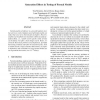1511 search results - page 11 / 303 » On the effectiveness of address-space randomization |
ISSRE
2002
IEEE
14 years 18 days ago
2002
IEEE
Formal analysis of software is a powerful analysis tool, but can be too costly. Random search of formal models can reduce that cost, but is theoretically incomplete. However, rand...
ASPLOS
1996
ACM
13 years 11 months ago
1996
ACM
This paper describes Shasta, a system that supports a shared address space in software on clusters of computers with physically distributed memory. A unique aspect of Shasta compa...
DIMVA
2008
13 years 8 months ago
2008
Over the past several years, US-CERT advisories, as well as most critical updates from software vendors, have been due to memory corruption vulnerabilities such as buffer overflo...
CLUSTER
2008
IEEE
14 years 2 months ago
2008
IEEE
—Remote atomic memory operations are critical for achieving high-performance synchronization in tightly-coupled systems. Previous approaches to implementing atomic memory operati...
DASFAA
2010
IEEE
13 years 5 months ago
2010
IEEE
Sampling streams of continuous data with limited memory, or reservoir sampling, is a utility algorithm. Standard reservoir sampling maintains a random sample of the entire stream a...

